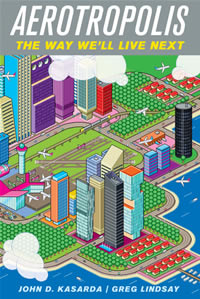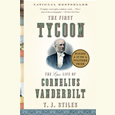Future Flight
Greg Lindsay and John D. Karsada envision a future of instant cities built around airports
In the Star Wars universe, Coruscant is a planet-wide city humming with constant air traffic and galactic commerce. Here on Earth, when cities and aircraft come together, there tend to be problems: noise pollution, traffic snarls, planes stacked for landing or parked to wait out storms as haggard travelers wander terminals in rumpled clothing. These problems will vanish in the future, according to John D. Karsada, a city planner and professor, and Greg Lindsay, a journalist. Their new book, Aerotropolis: The Way We’ll Live Next, describes a time when cities will be built from the airport outward. They describe a new kind of air-centric metropolis, connected to a “physical internet” in which goods and people are in constant global motion. Lindsay recently answered questions from Chapter 16 via email about the book and its vision of the future.
Chapter 16: How does your model for an “aerotropolis” differ from the supposedly futuristic cities imagined in the early twentieth century, at world fairs and in the pages of pulp magazines, where dirigibles and autogiros hovered among the skyscrapers?
Lindsay: For one thing, those visions of aircraft landing between skyscrapers (envisioned by Le Corbusier) or on a floating airport off the tip of Manhattan (as seriously suggested by “Futurama” designer Norman Bel Geddes) assumed that cities would remain full of dense skyscrapers forever, and also assumed aircraft would stay small. Instead, the fastest-growing metropolitan region in America over the last ten years (according to the recent Census) was Dallas-Ft. Worth, which sprawls in a fifty-mile radius from its airport. And the state-of-the-art in aircraft today is the Airbus A380, which weighs a million pounds at takeoff. No one is suggesting we build PopSci landscapes. What’s actually been built looks like DFW—the airport at the center of a large, diverse region, with the highest concentration of office space next door to the airport (in the form of Las Colinas) rather than in downtown Dallas. And as for what’s being built overseas, the results are closer to Shenzhen or Dubai—dense cores alternating with emptiness—than Gotham City.
 Chapter 16: With air terrorism an ever-present fear—and a continual cause for airport delays—how can the role of the airport within a city expand without compromising the security and comfort of its citizens?
Chapter 16: With air terrorism an ever-present fear—and a continual cause for airport delays—how can the role of the airport within a city expand without compromising the security and comfort of its citizens?
Lindsay: Is “air terrorism” in fact an “ever-present fear?” I don’t think so, and no one has quit flying in spite of potential terrorism—at least not enough to dampen the growth of air travel around the globe. The fact is that we are safer than ever in the sky—crashes are down, and terrorist incidents are down, especially compared to the endless litany of hijackings and bombings in the 1970s and 1980s. As for airports’ relationship to cities, aircraft are less polluting and less noisy than they were in the past, and the challenge is not to isolate airport as the ultimately LULUs (“locally undesirable land uses”), but to better accommodate them into the urban fabric—because people are going to settle there anyway. We need remediation, better transit connections, transit-oriented development, and sprawl infill around airports, rather than shunning them.
Chapter 16: You write: “Historically, cities exist to exchange goods between each other from their hinterlands—in Memphis’s case, that meant Mississippi cotton. FedEx exploded this notion with a hub capable of serving every city in the United States overnight, every night, turning the entire country into one big hinterland. … Memphis became the crossroads for potentially all of America’s goods, not just cotton.” While this change has certainly helped the city financially —you mention that the Memphis airport is directly or indirectly responsible for “nearly half” the local economy—has it helped the city in other ways? What happens to the culture and personality of a city when it becomes a major air hub?
Lindsay: Memphis and Louisville are special cases as cargo hubs. While FedEx and UPS have created tens of thousands of jobs in their respective cities, they’ve also become company towns to some extent, and that’s never a good thing. Furthermore, warehousing and distribution don’t create high-paying jobs. The challenge each city faces is leveraging their intense connectivity—an incredible public good for everyone else in America—to add value to the work performed in their cities.
 But in the case of a city which becomes a major passenger hub, the result is increased diversity. I’m sitting in a lounge at DFW as a write this, waiting for a flight. This afternoon, I spoke with local elected officials who told me about the huge influx of Indians and Southeast Asians into their communities—a demographic shift inspired in part by the airport. The same is true for the suburbs of northern Virginia, where Washington Dulles airport has had a profound effect on the region’s development. And then there are places like Dubai—the polyglot crossroads of the New Silk Road.
But in the case of a city which becomes a major passenger hub, the result is increased diversity. I’m sitting in a lounge at DFW as a write this, waiting for a flight. This afternoon, I spoke with local elected officials who told me about the huge influx of Indians and Southeast Asians into their communities—a demographic shift inspired in part by the airport. The same is true for the suburbs of northern Virginia, where Washington Dulles airport has had a profound effect on the region’s development. And then there are places like Dubai—the polyglot crossroads of the New Silk Road.
Chapter 16: In the absence of a massive air freight company like FedEx, what is the draw for a city to transform itself? How, for example, might Nashville, with its airport a distant southeastern suburb, become an aerotropolis? And what about small towns, located hours from the nearest airport?
Lindsay: The trend in America—especially in the face of high fuel prices—is to cut back on service to smaller airports and concentrate on the hubs, where there’s more traffic and great efficiencies. This means the challenge for small towns—and even mid-size cities like Nashville—is to create better connections to the hubs which exist now. That might mean some air service (in the case of Nashville) or, better yet, rail, and especially high-speed rail. While HSR is commonly seen as a substitute for air travel, it’s really a complement, increasing access to airports along its route, and binding smaller communities to neighboring large ones and national or international destinations beyond. The scope and scale of our economy has changed—we’re seeking to double exports in five years and also increase foreign investment. We need better connections to overseas, and for large cities that may mean hubs, while for smaller ones, it means better connections to those hubs.
Chapter 16: Aerotropolis has a co-author, John D. Kasarda, and yet the first-person narrative throughout the text is clearly your point of view. How did this collaboration come about? Why is yours the narrative voice?
Lindsay: John Kasarda decided twenty years ago that the instant cities of the twenty-first century—which are now being built at blinding speed across China, India, the Middle East, and Africa—would be built around airports, the better to plug into global trade lanes and supply chains. Then he went out and created a blueprint for how to do it. I was looking for a lens through which to shine a light on globalization and air travel when I profiled him for Fast Company in 2006, and I thought it made more sense for us to join forces than to launch potentially competing projects. I wrote the book in the first person because I wanted to ground the subject as much as possible for the reader—to show them what the superstructures and unintended consequences lumped together under the rubric of “globalization” actually looked and felt like, and I wanted to do it at human scale. I also wanted to serve as a translator and in some cases a buffer between the reader and Kasarda; they might have their own ideas as to whether the future that’s coming to pass is a good thing or not.
Greg Lindsay will discuss and sign copies of Aerotropolis: The Way We’ll Live Next on April 11 at 6 p.m. at Davis-Kidd Booksellers in Memphis.




